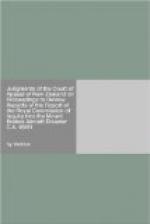The first question as to jurisdiction is therefore whether, apart from the 1972 Act, the applicants could have obtained relief by any of the proceedings mentioned. The Commission having ceased to exist, it would be too late to apply for prohibition or an injunction against the first respondent and mandamus would also be inappropriate. The decision of this Court in Reynolds v. Attorney-General (1909) 29 N.Z.L.R. 24, 37-38, suggests that once the report has been forwarded to the Governor-General it may be permanently beyond the reach of certiorari; this is perhaps a corollary of the view, to which we referred in the judgment concerning discovery in Environmental Defence Society Inc. v. South Pacific Aluminium Limited (C.A. 59/81, judgment 15th June 1981), that a prerogative remedy may not lie against the Sovereign’s representative.
But we need not go further into the rather technical question of the scope of certiorari in this kind of case. As has been said in the Environmental Defence Society case and Ng v. Minister of Immigration (C.A. 100/81, judgment 10th August 1981), a declaration may be granted in the discretion of the Court whether or not certiorari would have lain. That a declaration may be an appropriate remedy for both jurisdictional errors and closely analogous defects such as unfairness or breaches of natural justice is shown by such Privy Council and House of Lords decisions as De Verteuil v. Knaggs (1918) A.C. 557, Pyx Granite Co. Ltd. v. Ministry of Housing (1960) A.C. 260, and Ridge v. Baldwin (1964) A.C. 40. The statement apparently to the contrary at the end of the Reynolds judgment at p. 40 is obsolete. And if a declaration could have been granted that a decision made under a statutory power is invalid the Court has power under the 1972 Act to set the decision aside.
The Order for Costs
In argument in the present case it was common ground that if the order for $150,000 costs is invalid the Court can set it aside. That is clearly so. The order was made in reliance on s. 11 of the Commissions of Inquiry Act 1908 which (notwithstanding an argument to the contrary by Mr Harrison) is in our opinion undoubtedly the only source of any authority for a Royal Commission or a Commission of Inquiry to award costs. If valid it is enforceable by virtue of s. 12 of that Act as a final judgment of the High Court in its civil jurisdiction. Plainly it is the exercise of a statutory power of decision. The jurisdiction of the New Zealand Courts to determine the validity of orders for costs by Commissions is well established: Hughes v. Hanna (1909) 29 N.Z.L.R. 16; Whangarei Co-operative Bacon-Curing Co. v. Whangarei Meat-Supply Co. (1912) 31 N.Z.L.R. 1223; Pilkington v. Plaits (1925) N.Z.L.R. 864.




